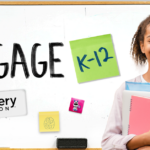By Kris Hughes
The misconception that only certain people are good at math forms in students’ minds at an early age. At Phineas Bates Elementary, inclusion specialists like me and our grade-level math co-teachers are helping students overcome that assumption by providing math instruction and resources that are adaptable to address a wide range of student needs.
While there is no one-size-fits-all approach at full-inclusion schools like Bates Elementary, educators have found a few best practices to support the success of every student in math. Here are four strategies that are making our math classes more equitable.
CHOOSING MULTI-GRADE PROGRAMS
Consistency, not just over a school year, but as a student progresses through different grades, can accelerate learning because it enables educators and students to have a shared language as well as common goals and experiences.
To create this consistency, Bates Elementary chose a dynamic math learning app to complement their existing standards-based math curriculum from pre-K through grade 5, ST Math. The program is a spiraling curriculum. This means that it introduces strategies and visual mathematical models at early levels that are then revisited as the student advances. Students complete standards-based puzzles using foundational knowledge and then continue to build mathematical understanding and proficiency by solving progressively more challenging puzzles. This process gives students the opportunity to build on what they learn, retain it, think flexibly, and apply it in new scenarios.
Additionally, ST Math uses spatial-temporal reasoning—the ability to mentally move objects through space and time to solve problems, making it equitable and accessible for all students. Since it is a visually driven program, all students can learn effectively, from the three-year-old mathematicians in the pre-K classrooms to the eleven-year-old problem-solvers in grade 5. The program’s visual instruction also reduces barriers for English language learners and students who struggle with reading.
EXPECTING (AND ENCOURAGING) PRODUCTIVE STRUGGLE
One of the biggest results of Bates Elementary’s shift to more equitable and inclusive math instruction has been an increase in students’ motivation.
Learning becomes a cycle of students trying a strategy, revising their plan if it doesn’t work, and making small adjustments along the way until they succeed.
We’ve built a culture of psychological safety that expects students to make mistakes and learn through them with problem solving. One of our mantras with students is “Mistakes Are Valuable.” We have a school-wide learning goal around productive struggle. Teachers expect students to persevere with challenging tasks when they are given proper instruction, tools, and support. In classrooms, students know they may not have the right answer immediately, but they can keep working until they do. Learning becomes a cycle of students trying a strategy, revising their plan if it doesn’t work, and making small adjustments along the way until they succeed. Support from other students, teachers, and formative feedback in the math program seeds a strong student-teacher relationship centered on trust and care.
CELEBRATING ACCOMPLISHMENTS
Recognition is part of the culture at Bates Elementary. Educators celebrate students, classes, and grades for meeting their math goals by awarding trophies, sharing achievements school-wide, and other strategies. It’s a way to honor the school’s commitment to equity and inclusion as well as keep students motivated.
One especially effective practice during remote learning was weekly video shoutouts. The videos focused on a specific goal and named individual students as well as the math methods they used to reach their goal. We showed the videos school-wide. By making the videos routine and prominent, educators increased recognition for students and provided an incentive for other students to keep working toward their goals. This year, now that we’re back learning in person, many of our classrooms feature ST Math celebration boards where top puzzle solvers are posted each week alongside other worthy data points like percent progress through the curriculum and class averages for our minutes and puzzle-solving goals.
PROVIDING MULTIPLE SUPPORTS
To underpin all the other strategies, educators at Bates Elementary give students multiple ways to get help when they need it. Multiple supports provide students agency, personalized learning, and an individual path to success.
One support is the formative feedback in the math technology classrooms use. Prompts from the program guide students through solving puzzles, but students are not left on their own. The school has created intentional and meaningful interventions from teachers and peers as well.
Teachers can provide students with individualized instruction because there are a variety of puzzles in ST Math. When a student is struggling with a concept, a teacher can assign a specific puzzle that helps them build the competency they need. Similarly, teachers use the math curriculum in group settings through something known as “puzzle talks.” Teachers introduce new concepts by projecting a puzzle onto a screen and then having the entire class solve it together.
Students get involved in support, too. Bates Elementary created ”ST Math Peer Helper” cards to give students ways to help their classmates. The cards let students know what they can and can’t do to help. For example, touching another student’s computer or directly giving them the answer is prohibited. But asking a question is allowed. The cards include the kinds of questions students can ask their peers who are stuck. Prompts such as what the peer wonders about the puzzle, what they have tried already, and what has and has not worked, guide the conversation. The support helps the student who is stuck and adds to the culture of inclusivity at the school by facilitating peer-to-peer support.
CLOSING THE OPPORTUNITY GAP
As all students continue to overcome COVID-19-caused learning losses, it’s more critical than ever for math education to be inclusive and equitable. Improving math instruction will close the opportunity gap and shift mindsets so that all students will believe that they are capable of succeeding at math. By implementing these tips and making math a schoolwide priority, other schools can replicate Bates Elementary’s success.
Kris Hughes is a Grade 4 inclusion specialist at Phineas Bates Elementary. She can be reached at khughes3@bostonpublicschools.org. For more information about ST Math and inclusive and equitable math instruction, go to stmath.com.
The American Consortium for Equity in Education, publisher of the "Equity & Access" journal, celebrates and connects the educators, associations, community partners and industry leaders who are working to solve problems and create a more equitable environment for historically underserved pre K-12 students throughout the United States.
- American Consortium for Equity in Educationhttps://ace-ed.org/author/admin/
- American Consortium for Equity in Educationhttps://ace-ed.org/author/admin/April 23, 2025
- American Consortium for Equity in Educationhttps://ace-ed.org/author/admin/
- American Consortium for Equity in Educationhttps://ace-ed.org/author/admin/







